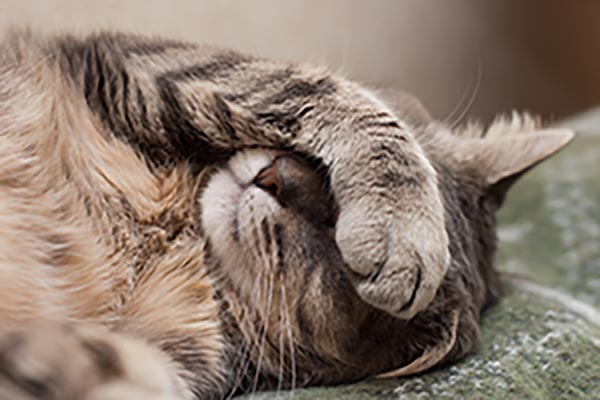Symptoms of Cat Flu

Could your kitty have cat flu? If she’s sneezing, wheezing, or has runny eyes, it’s certainly possible. Cat flu make a cat feel sick for anywhere from a few days to a few weeks. In some cases - particularly kittens and cats with immunity issues - cat flu can cause serious illness or even death.
However, fast action can usually prevent a worst case scenario. It’s important to know the symptoms of cat flu so you can seek a vet’s help as soon as possible.
What is Cat Flu?
First, let’s look at what exactly cat flu is: an upper respiratory infection, usually with a viral cause. About 80 to 90% of cases are caused by one of two viruses, feline herpesvirus (FHV) or feline calicivirus (FCV).
In rarer cases, bacteria can be the culprit. Chlamydophila felis, also known as cat chlamydia, and bordetella bronchiseptica, known as kennel cough in dogs, are bacterial causes of cat flu.
Whether caused by a virus or bacteria, the result is an upper respiratory infection that’s very uncomfortable for your kitty. Your vet will diagnose it by looking in your cat’s eyes, ears, and nose, and by discussing symptoms with you.
Common Symptoms
It can be hard to notice cat flu in reclusive cats. Particularly when sick, they may hide or avoid normal interaction during feeding times. You may need to bring them out of hiding to see whether they have cat flu symptoms.
Common symptoms include:
Lethargy. As your cat’s system works to fight the virus and secondary infection, it becomes very tired. The lethargy may be so severe, the cat doesn’t want to move at all - even to use the litter box.
Coughing, sneezing or difficulty breathing. Cat flu causes a buildup of mucus, which triggers coughing and trouble breathing. Your cat may pant or even dry heave, as a reaction to the mucus. Sneezing is very common.
Low appetite. Cats often don’t want to eat or drink when they have cat flu. Their stomachs may be upset, and their energy might be so low they don’t even feel like eating. Dehydration is a serious concern.
Runny eyes or nose. Discharge from the eyes and nose is very common - in fact, it can be the first symptom a cat owner notices. Your cat’s eyes or nose may seem watery, or they may seem clogged with sticky gunk.
Fever. A sudden or high fever is another common symptom of cat flu, although you might not know it’s happening. Fever can be worsened by dehydration and allowing the flu to go untreated.
Helping Your Pet Recover
Always see a veterinarian right away if you suspect cat flu. Although there are no effective antiviral treatments, antibacterial medications can help your cat fight off the infection and prevent complications like pneumonia. Eye drops or ointments can ease eye and nose pain.
In most cases, cats will recover from cat flu within 1 to 3 weeks without lasting symptoms. To prevent future recurrences, your vet may recommend vaccinations. These usually include vaccines for the feline herpes virus, the feline calicivirus, and bordetella.
Cat flu temporarily damages the delicate lining of your cat’s nose, airway, and possibly stomach and lungs. To assist with recovery at home, your vet may recommend:
- Plenty of rest
- Taking a break from brushing and petting
- Encouragement toward fluids, or eyedropper-fed liquids
- Soft, mushy foods
- Mixing food with water
- Strong-smelling foods that encourage eating
- Placing the litter pan near your pet’s rest area
Concerned about cat flu? Academy Animal Hospital can answer any questions you may have and provide preventive care for long-lasting cat health.
